In a world where consumers expect personalized experiences for each transaction, customer relationship management (CRM) is increasingly important. With it, businesses can improve customer retention and build loyalty, allowing them to increase sales in the long run. Thus, choosing a reliable CRM software is key to an effective strategy—and HubSpot and Zoho are among the products that are usually top of mind for those looking for one.
The only question now is which one of these two top CRM tools fits your business needs? In this article, we drill down into the similarities and differences between HubSpot vs. Zoho. With this information, you can make an informed decision about which tool is best for your unique business needs. It can also give a good idea of which tool is worth spending on.
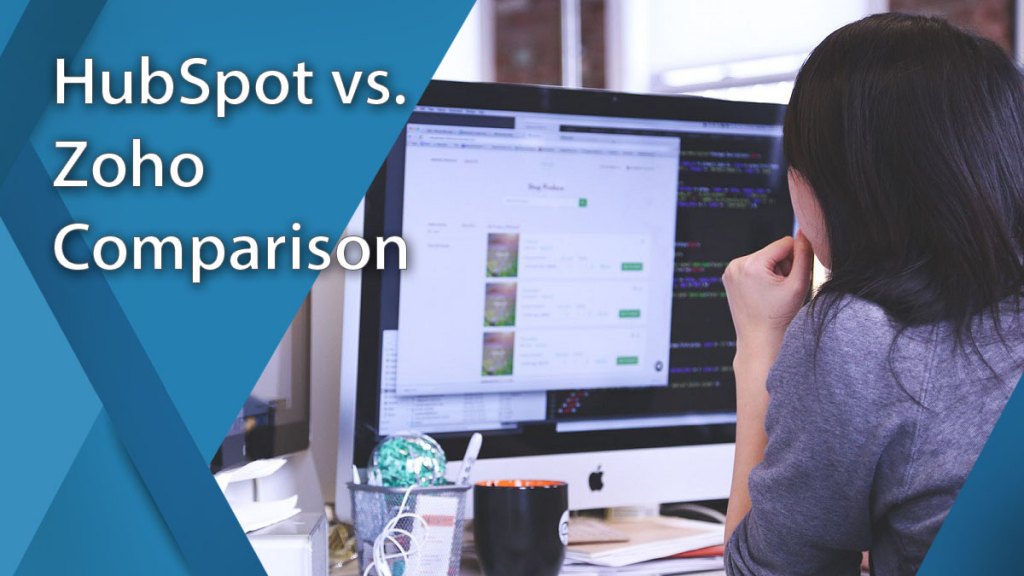
HubSpot vs. Zoho Comparison Table of Contents
Today, there are many CRM tools available on the market. Yet, marketers recognize that there exist gaps in the CRM industry. In a survey, one of the top CRM challenges is that 48% of marketers want tech solutions that are easier to integrate. This is followed by 43% of marketers who said that they want solutions that connect more easily to their stack. Another 42% said that they want better targeting and segmentation tools.
Top CRM Challenges
Tech solutions that are easier to integrate: 48%
Tech solutions that are easier to integrate
48%Easier access to customer data: 44%
Easier access to customer data
44%Solutions that connect more easily to my stack: 43%
Solutions that connect more easily to my stack
43%Better targeting and segmentation tools: 42%
Better targeting and segmentation tools
42%Better personalization capabilities: 41%
Better personalization capabilities
41%More flexibility when it comes to technical solutions: 37%
More flexibility when it comes to technical solutions
37%Capabilities to measure campaign performance: 20%
Capabilities to measure campaign performance
20%Other: 2%
Other
2%Source: Tinyclues, 2022
Designed byAnother challenge that CRM professionals have to deal with is the integrity of their CRM data. Most CRM users assume that they have clean and meaningful data but nothing can be farther from the truth. Data shows that 75% of respondents say that they fabricate data in order to tell the story that decision-makers want to hear. It turns out that not having accurate data hurts employee motivation. The same survey revealed that 64% of respondents said that they would consider quitting their jobs.
With these in mind, it is important to understand that while there are plenty of quality platforms you can choose from, not all will be able to meet your CRM requirements. As such, it is important to closely look under the hood of your prospective software.
Overview of HubSpot and Zoho
HubSpot

HubSpot is an intuitive software that combines your CRM, sales, marketing, operations, and customer service in one hub. This award-winning software helps teams manage their inbound marketing for a seamless customer journey. With HubSpot, businesses can get more qualified leads, convert leads into customers, resolve customer issues, and connect various apps in one solution. HubSpot can be used in various industries such as education, nonprofit, manufacturing, consumer services, and more. As a marketing hub, its popular features include lead generation, marketing automation, and analytics. As a sales hub, its key features include advanced CRM capabilities, meeting scheduling, and payments. With its extensive features, HubSpot has earned a spot as one of the top 3 CRM solutions today.
Zoho

Zoho bills itself as a complete solution that not only houses a CRM platform but also has tools for finance, HR, IT management, marketing, and for an online workplace. With Zoho CRM, you can reach customers across all channels, automate repetitive tasks, obtain reports and insights in real-time, and use artificial intelligence to boost your sales. It can be used both by growing businesses and enterprises and can be used in various industries such as retail, real estate, insurance, and more. Key features of this software include sales forecasting, email insights, workflow rules, conversational AI, and automated lead generation from social media.
Comparison of HubSpot vs. Zoho
Core Features
Campaign Management
HubSpot equips marketers with the tools they need to build, manage, and collaborate on campaigns from one place. This web-based CRM software allows you to set up your campaign by identifying your audience, setting campaign start and end dates, and creating tracking URLs. After you set it up, you can use the software’s campaign orchestration tools that allow you to specify what assets to include in your campaign. These include blog posts, social media posts, calls to action, and the like. The software also includes collaboration tools that let you to assign tasks, track timelines, and communicate with others right from HubSpot. After your campaign, you can conduct A/B testing to analyze which landing pages and emails were most effective in converting customers.
On the other hand, Zoho tools for campaign management are limited to email marketing. For this particular core function, personalization is one of Zoho’s key benefits. With this feature, you can add videos to emails, address customers by their name, and email your contacts from the same salesperson. On the other hand, email deliverability features such as compliance with anti-spamming laws and sending only from authenticated emails. You can also set email sending limits to ensure that you don’t send too many or too few emails.
Contact Management
With HubSpot’s contact management features, you can add contacts from your Gmail, Outlook, or Office 365 inboxes. You can also add contacts manually by using your prospect’s email address or import them from form submissions. After you create new contacts, HubSpot will automatically create a related company record and fill it out with the relevant information. This includes revenue, industry, and contact details from its database of more than 20 million businesses. Users can create as many as one million contacts without repetitive manual work. With all important details in the system, you eliminate the need to switch from one platform to another to perform tasks.
On the other hand, the contact management features in Zoho include omnichannel communication so that you can reach out to customers through multiple channels such as email, phone, and social media. With two-way sync, you can see help desk tickets under leads and contacts, while contact information is also displayed for each ticket in your help desk tool. With Zoho, you can also stay on top of social media conversations as they happen on Facebook or Twitter. With this, you don’t have to buy separate social CRM software. Zoho users have a social dashboard that gives them a glimpse of the posts and conversations relevant to their business.
Workflow Automation
With HubSpot, you can create workflows to automate your marketing, sales, and service processes. You can create blank, scheduled, or contact-based workflows in a few steps. You can use a template, then set enrollment triggers, add actions, manage settings, then turn on your workflow. Users can add up to 250 filters for the enrollment triggers of a workflow. Common workflow enrollment triggers include property values, association labels, activities, line items, and subscriptions, among others.
On the other hand, Zoho has a workflow automation tool called Zoho Creator. With it, you can design workflows, automate tasks, share applications, and publish and monitor workflows. Users can choose from more than 32 field types to gather data from forms. The script builder features drag-and-drop capabilities that make designing workflows faster and more intuitive. Like HubSpot, it has pre-built workflow templates for attendance management, leave tracking, employee onboarding, document review, and invoice approval.

You can create workflows in Zoho through drag-and-drop motions.
Lead Management
HubSpot’s lead management functionality gives you all the tools you need to manage leads from one central location. HubSpot allows you to check lead data such as the client’s profile and the chronological timeline of touchpoints. It allows you to assign lead scores so you know which leads your sales team should prioritize. It also automatically logs sales activities so you can nurture your pipeline and reduce your time spent on lead management. Lastly, it allows you to segment leads so you can personalize your marketing messages based on customer data that you have collected.
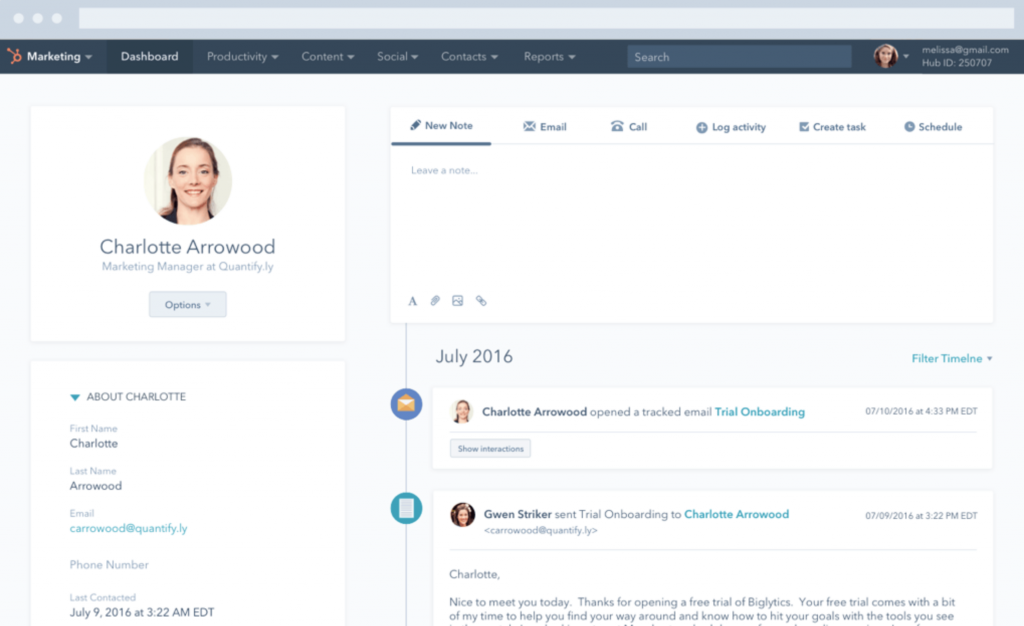
Adding contacts is a breeze with HubSpot.
On the other hand, Zoho also offers an extensive array of lead management features. It features smart webforms that allow you to build forms using intuitive drag-and-drop methods. The software is capable of capturing leads on landing pages hosted on WordPress, Unbounce, Joomla, and other CMS even if you don’t know how to code. Converting business card information to leads in your CRM is more convenient with business card and QR badge scanning. At the same time, engaging with customers in real-time on your website is easier with live chat reporting, which generates easy-to-understand graphs about visitors by region and visits by search keyword. Other notable features include social media management, Facebook lead generation, lead enrichment, lead scoring, and lead distribution.
Reporting and Analytics
HubSpot has powerful reporting features that allow you to build custom reports and dashboards in just a few seconds. You can create attribution reports that help you identify marketing efforts that resulted in the most leads, deals, and revenue. You can filter reports based on contact creation date, lifecycle stage and date, contact lists, and lifestyle stage. It also features customizable dashboards that you can share publicly, privately, or for specific users only.
Zoho Analytics is the reporting component of Zoho that allows you to create various types of charts. With this feature, you can display data in pivot tables, summary views, or tabular views. Zoho Analytics also allows you to create different custom dashboards such as cost analysis dashboard, sales analysis dashboard, and sales vs. cost dashboard. To organize reports, you can add up to 10 tabs. Dashboards components can be reorganized through simple drag-and-drop features. Components can be resized as well to fit your preferred width or space.
HubSpot vs. Zoho Core Features Key Takeaways:
- HubSpot and Zoho have similar contact management, workflow automation, and reporting and analytics capabilities.
- The two products, however, differ starkly when it comes to campaign and lead management features.
Integrations
HubSpot offers more than 1,030 integrations via the HubSpot App Marketplace. The marketplace offers integrations with a wide variety of apps such as sales, finance, marketing, productivity, and customer service. Among the popular HubSpot app integrations are Gmail, Google Ads, Zapier, Google Calendar, Outlook, and HubSpot for WordPress.
Zoho CRM likewise offers many integrations with a wide range of app categories. These include apps for finance, telephony, messaging, office productivity, events and meetings, quote management, document signer, and more. Popular integrations include Google Workspace, Microsoft 365, Slack, Shopify, MailChimp, and Facebook Ads.
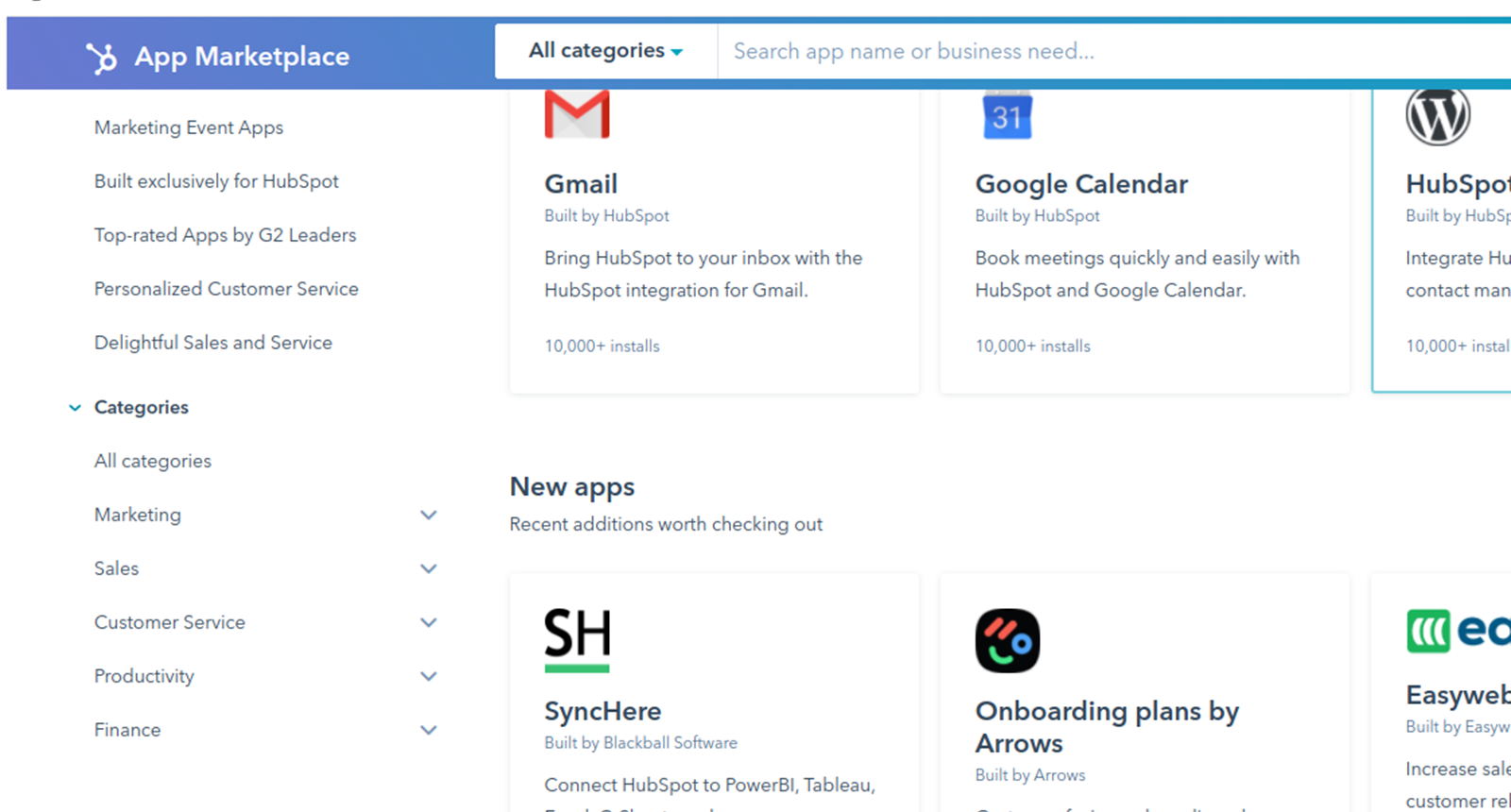
HubSpot has a vast and searchable app marketplace.
HubSpot vs. Zoho Integrations Key Takeaways:
- HubSpot offers more integrations than Zoho owing to the vast number of apps in its App Marketplace.
- Despite HubSpot upstaging Zoho in terms of integrations, they share common integrations in office productivity, email marketing, and social media app categories.
Pricing
HubSpot offers three pricing plans that range between $23 per month and $1,200 per month, depending on the functions you will be needing. The platform also has a free CRM plan that is great for smaller businesses that have yet to scale up their operations. For those who only need basic CRM tools, the vendor also offers a Starter CRM suite at $45 per month. All paid plans include storage for up to 15 million overall contacts and one-on-one technical support.
Similarly, Zoho CRM offers a free plan that includes basic features. Meanwhile, its paid plans range from $20 per user per month to $65 per user per month and are also priced according to the functionalities you’ll be needing as well as your required number of records, pipelines, and workflows. For smaller companies, the vendor also has a plan called Bigin by Zoho CRM at $7 per user per month. In addition, companies that are looking to create unified customer experiences can benefit from their Zoho CRM Plus plan, which is priced at $57 per user per month.
Both HubSpot and Zoho offer free forever plans, which means businesses of all sizes can test-drive the software before they commit to a subscription. After the free-forever plan, both also have starter plans at roughly the same price points, which means that it’s a toss-up between the two if you are a small business and you only need basic CRM features. However, for higher-tiered plans, Zoho has more affordable price points, making it ideal for mid-sized businesses and enterprises who want a feature-rich CRM at competitive rates.
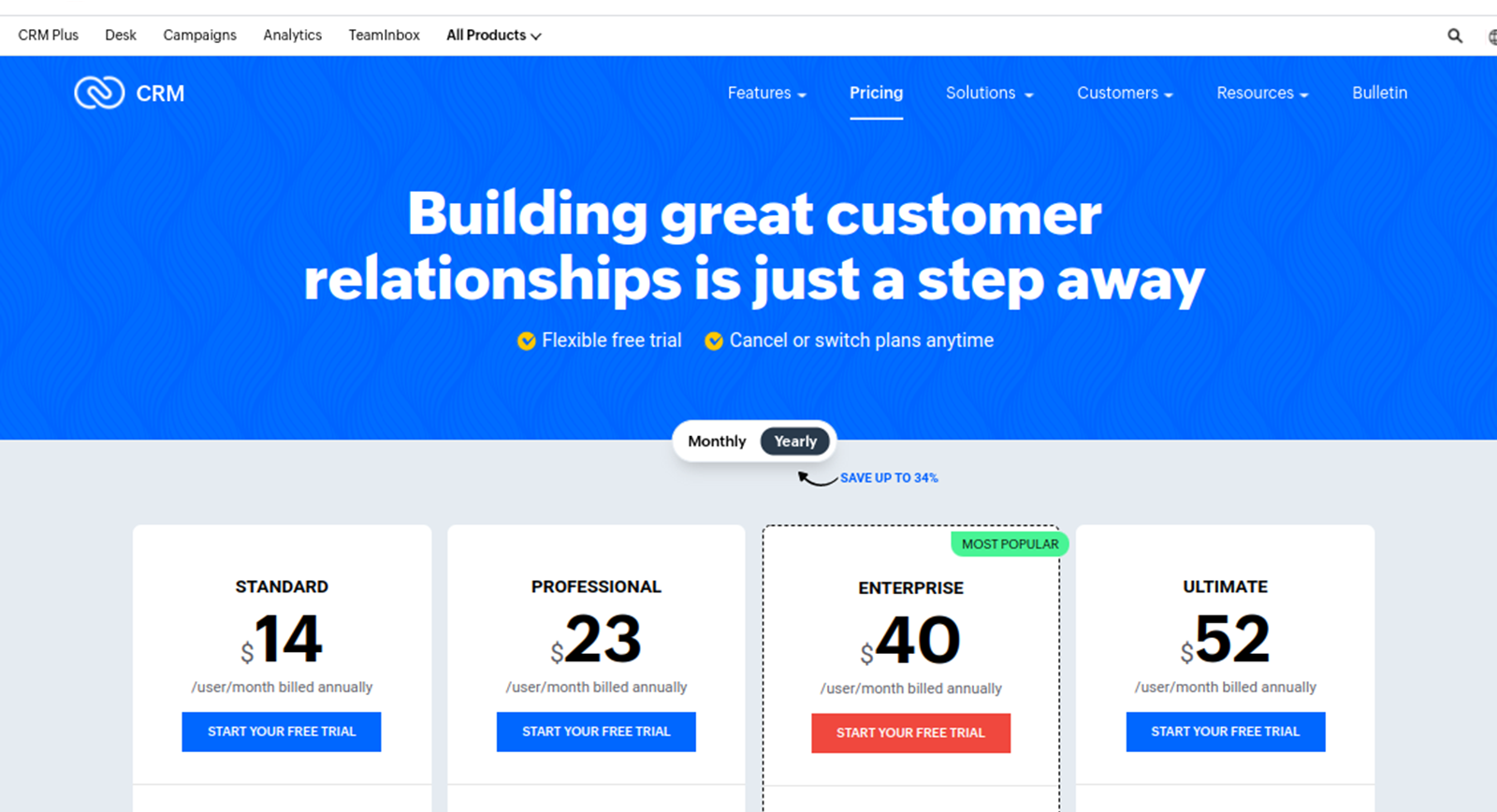
Zoho CRM features affordable prices at all plan tiers.
HubSpot vs. Zoho Pricing Key Takeaways:
- Both HubSpot and Zoho offer free versions of their CRM solution.
- Both HubSpot and Zoho offer affordable pricing plans for lower-tiered packages. However, Zoho offers more affordable price points at the higher-tier plans.
Ease of Use
One of the key features of HubSpot is a drag-and-drop email editor, which makes it intuitive to add and modify elements of the layout of your content. HubSpot also offers downloadable free business templates for inbound marketing to save you the time and effort in creating one. These include templates for marketing plans, value chain analysis, free marketing mix, customer journey map, and more. Should you need help with navigating the tool, HubSpot has an extensive knowledge base where you can find answers to your questions.
Drag-and-drop functionality also figures in Zoho’s tools. You can drag and drop elements of campaign workflows. You can also drag and drop email attachments to your CRM or events while building an app. It has a clean interface where similar information is grouped into panels. You can easily view leads through standard view and custom list views.
HubSpot vs. Zoho Ease of Use Key Takeaways:
- Both HubSpot and Zoho feature drag-and-drop functionalities, which make them easy to use.
- HubSpot has a slight advantage over Zoho when it comes to employee onboarding.
Getting Started
HubSpot offers CMS Hub Onboarding services under Professional and Enterprise plans. With this service, you get custom recommendations from an expert on how you can set up your data and your website live in HubSpot. You can also get tips on how to optimize your website and blog, your content strategy, lead capture and conversion paths, and traffic and website analysis. The Enterprise plan offers more services at a higher price. Onboarding services under both plans are delivered remotely. When it comes to onboarding, small business users have given feedback on how HubSpot is easy to set up and use for employees.
Meanwhile, onboarding in Zoho requires a multi-step process. First, you have to enter basic company details, then invite users, and set up data sharing. Then, you need to set up access restrictions, quick-customize modules, set up basic workflows, and set up email and account templates. This has led to user feedback saying that Zoho is that onboarding new users can be a little time-consuming. At any rate, however, Zoho support is available to users who experience issues with onboarding.
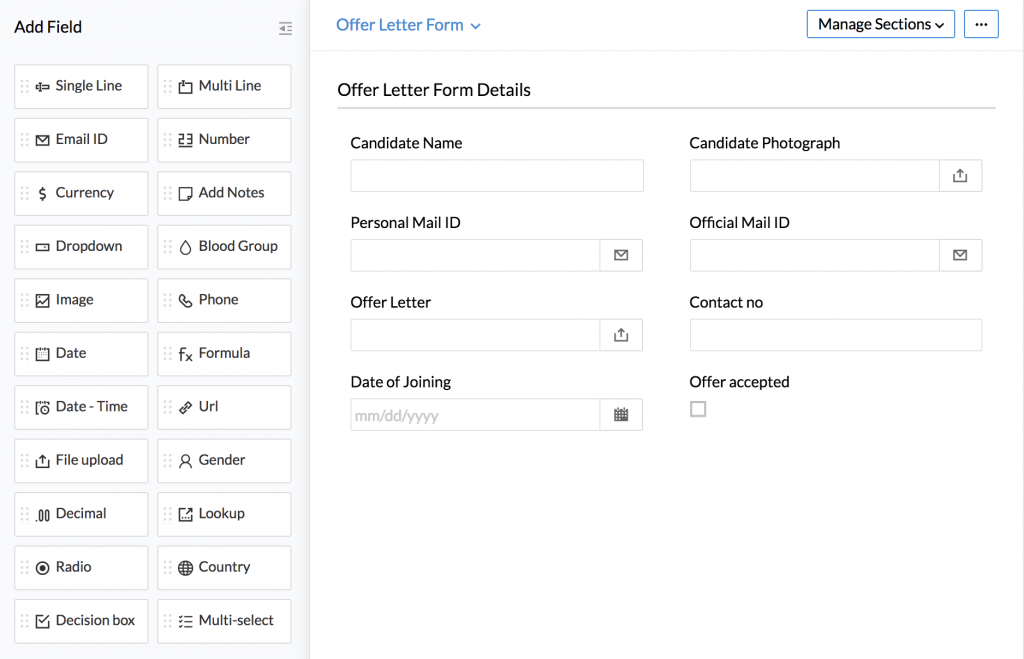
Part of the Zoho onboarding process is filling out account information.
HubSpot vs. Zoho Getting Started Key Takeaways:
- HubSpot is easy to set up and offers plans for onboarding with professional support.
- Onboarding with Zoho requires multiple steps, which can be time-consuming for some users.
Use Cases
HubSpot is ideal for small businesses, medium-sized businesses, or enterprises that are growing to scale. Thus, you don’t have to make a choice between enterprise CRM software and small business CRM. HubSpot can also be used by any team whether in sales, marketing, operations, customer service, or by executive-level managers. It has been used by more than 10,000 companies in various industries with employee counts that range from one to over 10,000.
Zoho is used by more than 250,000 businesses in more than 180 countries. It can be used by start-ups, small businesses, and enterprises. It can be applied to various industries as well, including retail, real estate, services, and more. The tool can be customized to fit unique business scenarios and use cases. These include customer geolocation on a map and a fully automated follow-up or quoting process.
HubSpot vs. Zoho Use Cases Key Takeaways:
- Both HubSpot and Zoho are being used by businesses of all sizes in a wide range of industries.
- Zoho offers customization for unique business scenarios and use cases.
Hubspot vs. Zoho Comparison Table
| HubSpot | Zoho | |
| Ideal for |
|
|
| Use cases |
|
|
| Core Features | ||
| Campaign Management | ✓ | ✓ |
| Contact Management | ✓ | ✓ |
| Workflow Automation | ✓ | ✓ |
| Lead Management | ✓ | ✓ |
| Key Integrations | ||
| Slack | ✓ | ✓ |
| Facebook Ads | ✓ | ✓ |
| Mailchimp | ✓ | ✓ |
| Shopify | ✓ | ✓ |
| Pricing | ||
| Starts from | $23 per user/month | $14 per user/month |
| No. of plans | 5 | 7 |
HubSpot vs. Zoho — Which is better?
When you make a comparison between HubSpot vs. Zoho, you would see that they have more similarities than differences. Both have drag-and-drop functionalities that make them among the most easy-to-use CRM software in the market. Both also have lead management, customizable dashboards, and contact management capabilities. However, there are slight differences only in how these core features are implemented in each tool. For example, contact management in HubSpot focuses on pulling contacts from one’s inbox whereas Zoho supports an omnichannel approach.
Aside from these, both tools can handle businesses of all sizes and can address the needs of various industries. Last but not least, HubSpot and Zoho offer affordable pricing plans, making both great for companies on a budget. Ultimately, the question of which tool is better boils down to the needs of your business and your budget.










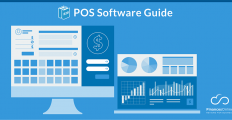

















Leave a comment!